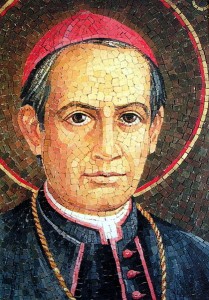 Anthony Mary Claret was a Catalan Spanish Roman Catholic archbishop and missionary, and was confessor of Isabella II of Spain. Born in Sallent, Bages comarca, near Barcelona, on December 23, 1807, the son of a small woolen manufacturer. He received an elementary education in his native village, and at the age of twelve became a weaver. Later he went to Barcelona to specialize in his trade, and remained there until he was twenty. Meanwhile he devoted his spare time to study and became proficient in Latin, French and engraving.
Anthony Mary Claret was a Catalan Spanish Roman Catholic archbishop and missionary, and was confessor of Isabella II of Spain. Born in Sallent, Bages comarca, near Barcelona, on December 23, 1807, the son of a small woolen manufacturer. He received an elementary education in his native village, and at the age of twelve became a weaver. Later he went to Barcelona to specialize in his trade, and remained there until he was twenty. Meanwhile he devoted his spare time to study and became proficient in Latin, French and engraving.
Recognizing a call to religious life, he left Barcelona. He wished to become a Carthusian but finally entered the seminary at Vic in 1829, and was ordained on June 13, 1835, on the feast of Saint Anthony of Padua, his namesake. He received a benefice in his native parish, where he continued to study theology until 1839; but as missionary work strongly appealed to him, he proceeded to Rome. There he entered the Jesuit novitiate but had to leave due to ill health. He then returned to Spain and exercised his pastoral ministry in Viladrau and Girona, attracting notice by his efforts on behalf of the poor.
In 1848 he was sent to the Canary Islands where he gave retreats for fifteen months. On his return to Spain, he established in 1849 the Congregation of the Missionary Sons of the Immaculate Heart of Mary (The Claretians); he also and founded the great religious library at Barcelona which was called “Librería Religiosa” (now “Llibreria Claret”), and which has issued several million inexpensive copies of the best ancient and modern Catholic works.
His labors bore fruit: Pope Pius IX, at the request of the Spanish crown appointed him Archbishop of Santiago, Cuba in 1849. In 1850, having arrived at his destination, he began at once the work of thorough reform.
The Santiago seminary was reorganized, clerical discipline strengthened, and over 9,000 marriages validated within the first two years of his arrival. He erected a hospital and numerous schools. Three times he made a visitation of the entire diocese, giving local missions incessantly. His zealous works stirred up much opposition in the anti-clerical mood of the period, as had happened previously in Spain. No fewer than 15 attempts were made on his life, and at Holguín his cheek was slashed from ear to chin by a would-be assassin’s knife.
In February, 1857, Claret was recalled to Spain by Queen Isabella II, who made him her confessor. His influence was now directed solely to help the poor and to propagate learning; he lived frugally and took up his residence in an Italian hospice. For nine years he was rector of the Escorial monastic school, where he established a scientific laboratory, a museum of natural history, a library, college and schools of music and languages.
In 1869 he went to Rome to prepare for the First Vatican Council. Owing to failing health he withdrew to Prada de Conflent in the French Pyrenees, where he was still harassed by his Spanish enemies; shortly afterwards he retired to the Cistercian abbey at Fontfroide, Narbonne, southern France, where he died on October 24, 1870, aged 63.
In addition to the Claretians, which in the early 21st century had over 450 houses and 3100 members, with missions in five continents, Archbishop Claret founded or drew up the rules of several communities of Religious Sisters.
His zealous life and the wonders he wrought, both before and after his death, testified to his sanctity. Anthony Mary Claret was beatified in Rome by Pope Pius XI on February 24, 1934. He was canonized sixteen years later by Pope Pius XII on May 7, 1950.


